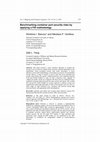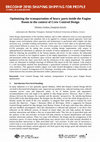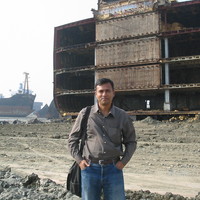Papers by Nikolaos Ventikos

Proceeding of the 33rd European Safety and Reliability Conference
The shipping industry increasingly relies on Information Technology (IT) and Operational Technolo... more The shipping industry increasingly relies on Information Technology (IT) and Operational Technology (OT), which undoubtedly improve operations but also jeopardize vessel safety and security. Risks may arise from vulnerabilities in the design, operation, integration, connection and maintenance of these systems, that external or internal threat agents could exploit. This paper presents a cyber-risk assessment model utilizing Bayesian Networks (BN) for real-time crisis classification of cyber security incidents attributed to detected vulnerabilities in the IT and OT systems on passenger ships. The model is part of a crisis classification module under development for the EU-funded project ISOLA, which visions an intelligent security superintendence ecosystem to enhance the existing ship security processes and the protective measures applied onboard passenger ships. ISOLA's services provide functions for continuous surveillance, including cyber security functions. The BN model receives specific IT and OT vulnerability data generated by a specialized ISOLA service and employs Bayesian probabilistic techniques to evaluate any identified vulnerability. The model performs real-time crisis classification of the cyber security-related incident, utilizing a six-level ascending scale for crisis taxonomy and generates relevant warnings to alert the crew and facilitate early detection of potential or actual safety-and security-threatening occurrences.
The 26th International Ocean and Polar Engineering Conference, Jun 26, 2016
The stochastic nature of the LNG site-by-site offload operations configures a complex marine syst... more The stochastic nature of the LNG site-by-site offload operations configures a complex marine system where the time for decisions is limited and critical. This paper presents a Fuzzy Inference System (FIS) methodology for the dynamic monitoring of the loading arm reactions. The methodology integrates the environmental conditions to calculate the risk of the loading arm to fail during the operation. Experimental data retrieved by the coupled motion response analysis of two LNG carriers were used for the tuning of the model's parameters. The outcome of the model is a risk failure indicator that helps operators decide whether to continue or suspend the operation.

Multiple criteria decision making, Sep 9, 2016
Nowadays Ship-to-Ship (STS) transfer has become common practice. However, it remains a complex an... more Nowadays Ship-to-Ship (STS) transfer has become common practice. However, it remains a complex and difficult procedure, with risk assessment essential for both vessels and location selection. A variety of risk assessment techniques are thus commonly applied in order to evaluate the factors affecting STS transfers. This paper proposes a novel approach to the risk assessment of different locations for STS transfer operations, using the ELECTRE methodology borrowed from the Multi Criteria Decision Aid (MCDA) discipline. The proposed MCDA methodology is properly developed and thoroughly analysed with the aim of supporting operators in choosing the best alternative STS location. To this end, a case study is presented with which to testify the effectiveness and verify the strength of the suggested approach. In particular, four different locations within the Mediterranean Sea, which represent the set of alternative actions, are evaluated according to four different groups of criteria, with a view to selecting the most appropriate location at which to conduct the transfer operations. Different operational, economic, environmental and safety-security criteria regarding each location are assessed and evaluated by a team of three experts designated by the stakeholders (decision makers) of a shipping company. In addition, a robustness analysis is performed in order to control the stability of the model results. The objective is to develop an MCDA model with which to select the most appropriate location according to its operational eligibility.
International Journal of Offshore and Polar Engineering, Sep 1, 2017

International series in management science/operations research, Oct 25, 2017
Decision making in the maritime environment is a complex and difficult task. The stochastic natur... more Decision making in the maritime environment is a complex and difficult task. The stochastic nature of maritime operations, in combination with the complicated and often hostile sea setting, composes a scene where obvious solutions are not always the best choice. The assessment and evaluation of risks often lays on the exploitation of the experts’ knowledge. However, this approach may suffer from uncertainty, stemming from potential biases inherent to the opinions of the experts. The aim of this chapter is to evaluate the risks of a ship-to-ship transfer of cargo operations, proposing a challenging approach to address the aforementioned uncertainty, by utilizing a sophisticated and targeted multi-criteria decision aid (MCDA) framework. The STOCHASTIC Utility Additives (UTA) method, adopting the philosophy of aggregation–disaggregation, is applied, coupled with a robustness control procedure. This methodological framework helped in the examination, management and reduction of uncertainty, and in the eventual attainment of robust and reliable evaluation results.

International Journal of Shipping and Transport Logistics, 2018
This paper presents a fuzzy inference approach to estimate the security level of a port in a mann... more This paper presents a fuzzy inference approach to estimate the security level of a port in a manner that it provides essential information to the stakeholders when evaluating security risks under uncertainty. A fuzzy inference system (FIS) methodology is developed on account to four predefined security factors. A team of experts is used to rank and survey potential port security risks whereas the experts' ordinal preferences were combined using the Cook and Seiford method to come up with a consensus risks' ranking. To validate the model, results are compared with those from an established fuzzy evidential reasoning approach given the same security risk inputs. The verified FIS can provide useful insights for security analysts to conduct security risk quantification under high uncertainty in data in the maritime sector as well as a wider range of other industries (e.g., aerospace and process) facing high terrorism threats with appropriate tailor and adaptation.

International Journal of Decision Support Systems, 2016
Ship-to-ship (STS) transfer of cargo operations suffers inherently from risks that can compromise... more Ship-to-ship (STS) transfer of cargo operations suffers inherently from risks that can compromise the success of such operations, leading to an accident with adverse effects on human lives and the environment. A feasible way to tackle the risks of STS transfers is through the use of multicriteria decision aid (MCDA) methodologies. This paper aims to develop an MCDA model to evaluate risks of an STS transfer based on the outranking relation concept. The proposed methodology uses confidence indices to compare alternative risk scenarios on stochastic risk criteria evaluation. To do so, a team of experts evaluate the scenarios regarding three risk factors; the likelihood of a scenario to occur, the severity of the scenario and the ability to detect the risk on time. Next, fuzzy domination relation is applied to complete the ranking of the risks. Finally, robustness analysis is performed to control the model's stability.

Nature
I n January last year, a Japanese car ferry, the Soleil, became the first large vessel to navigat... more I n January last year, a Japanese car ferry, the Soleil, became the first large vessel to navigate without human intervention. The 220-metre-long ship automatically berthed and unberthed, turned, reversed and steered itself for 240 kilometres across the Iyonada Sea from Shinmoji in northern Kyushu-manoeuvres that even skilled human operators find challenging. It is early days, but ships are increasingly deploying sensors and artificial-intelligence (AI) systems to navigate, steer and avoid collisions. As with cars, such advances should improve safety, increase efficiency andalong with cleaner fuels and engines-reduce environmental impacts. This is crucial: 80% of global trade (around 11 billion tonnes) is transported by sea each year 1. In 2018, shipping generated around 3% (about 1,000 million tonnes) of global carbon dioxide emissions 2. The International Maritime Organization (IMO) has committed to halving the industry's greenhouse-gas emissions by 2050. Seafaring is risky and workers are in short supply. Inefficiencies and congestion at ports add delays and costs, as do accidents, such as the grounding of the container ship Ever Given in the Suez canal for six days in March 2021. Streamlining passage through locks, reducing energy consumption and negotiating manoeuvres to avoid collisions would enable safer and more optimal use of waterways. Some small, fully autonomous boats,

Zenodo (CERN European Organization for Nuclear Research), Jun 15, 2023
About 74% of imports/exports and 37% of exchanges go through ports, making Europe highly dependen... more About 74% of imports/exports and 37% of exchanges go through ports, making Europe highly dependent on ports for external and internal trade. In the European container supply chain, Short Sea Shipping (SSS) as well as inland waterways are not so well integrated in contrast to Deep Sea Shipping (DSS) ports (also referred to as Hub ports). MOSES is a European project, funded under the Horizon 2020 Work Programme, which aims to significantly enhance the SSS component of the European container supply chain by addressing the vulnerabilities and strains that relate to the operation of large containerships. The project develops a number of components that function as nodes of the Physical Internet, consisting of a number of data sources that when combined can lead to the development of meaningfull applications. Based on the technical innovations that are designed and developed, MOSES aims to reduce the environmental footprint for SSS and ports and improve the efficiency and end-toend delivery times of SSS mode. In parallel, it will enable the promotion of smart port development with minimal investment and the development of concrete business cases.
CRC Press eBooks, Aug 22, 2019

WMU studies in maritime affairs, 2018
The establishment of regulatory requirements from the International Maritime Organization to effe... more The establishment of regulatory requirements from the International Maritime Organization to effectively control and limit toxic gas emissions from ships has sparked a debate on whether ships are adequately equipped to safely operate in various weather conditions when complying with these requirements by simply dating the main propulsion engine. This study deals with assessing and analysing the risk of navigational accidents, i.e. collisions, groundings, and contacts, that occurred under adverse weather conditions and may have been related to the lack of sufficient powering and manoeuvrability. The risk assessment methodology that has been developed for this study is based on the concept of risk triplets that is used to connect an adverse scenario to the frequency and the resulting consequences. The adverse scenarios are defined using a set of parameters, including ship type, size, class, accident category and installed main engine power. The implementation of risk triplets allows a more detailed assessment of the accident risk and incorporates enough information to produce various graphical risk curves that are used to compare the different adverse scenarios and focus on the ones with the highest risk. The study concludes with interesting results regarding high risk ship types and insights that can be used to strengthen the case for science-based policy making in the maritime industry.

Some design requirements in the maritime industry and in other industries exist to cover operatio... more Some design requirements in the maritime industry and in other industries exist to cover operational and maintenance aspects but somehow fail to be applied in a human centered approach. Such bad designs create environments where operation and maintenance is performed with a higher risk than necessary (e.g. crowded working environment, valves too close to each other to be operated easily, valve/control difficult to reach, etc.). The aim of this paper is to implement Crew Centered Design (CCD) principles and by taking into account existing design requirements with respect to anthropometrical limitations to optimize the transfer of heavy equipment in a vessel's Engine Room (ER) by reducing the possibility of the human injuries and errors. In this context, the elaborated analysis is focused on two logistical aspects of the engine department: (1) movement of equipment and personnel within the machinery space to/from specified nodal locations and (2) movement of equipment to/from the ship's main deck and the entrance(s) of the engine department. The optimal routes are illustrated in multiple drawings of different ERs based on the link analysis. Link analysis is a task description method that demonstrates a generalized summary of activities performed by crew members. This approach enables engine crew tasks located throughout a ships structure to be represented in General Arrangement (GA) drawings, revealing node connections, relationships and routes between key locations and functions within a physical space.
Day 1 Tue, March 07, 2023
Decarbonisation in maritime industry can be possible by considering renewable sources of energy o... more Decarbonisation in maritime industry can be possible by considering renewable sources of energy or various novel technologies for improving the environmental footprint. The established strategy and the respective regulatory framework are pushing hard towards this direction, while the European Union (EU) introduces regulations and initiatives to accelerate the transition. Each decarbonisation effort should be closely examined both in terms of emissions and cost in order to prove its benefits to the environment and ship owner, respectively. Uncertainties should be carefully considered, especially when it comes to carbon pricing and fuel prices. This paper lays the path towards life-cycle assessment and costing for alternative fuels and emission reduction technologies, while an indicative case study is qualitatively considered.

Transportation Safety and Environment
The development of innovative, complex marine systems, such as autonomous ship concepts, has led ... more The development of innovative, complex marine systems, such as autonomous ship concepts, has led to risk-based approaches in design and operation that provide safety level quantification and continuous risk assessment. The existing approaches to dynamic risk assessment mainly aim at updating accident probabilities for specific risk scenarios, based on knowledge of system operation and failure, as well as on past accident and failure information. However, for innovative marine systems that include complex interactions, our ability to identify anything that might go wrong is very limited, which may lead to unidentified risks, and failure data may not be available. This paper presents the foundations of a framework for dynamic risk assessment, which is equally applicable to manned and autonomous ships and mainly relies on information about the safe operational envelope and real-time information regarding deviations from safety. Inspiration is drawn from how the biological immune system...

The shipbuilding industry has experienced significant changes over the course of the last century... more The shipbuilding industry has experienced significant changes over the course of the last century. Traditional ship building nations such as the UK and USA, followed by a flourishing industry in Europe, were gradually replaced by China, Japan and South Korea by the end of the 20th century. The reasons for the pronounced shift to the Far East and Asia over the last decades have been several and diverse. Currently, about 85% of the shipbuilding industry is concentrated in the three nations mentioned previously and often the quality of new builds post the shift to the Far East and Asia has been questioned. The main objective of this paper is to investigate the circumstances and changes that have taken place in the ship building industry in the past decades and explore their impact, if any, on ship safety. This study presents the findings of one pilot data collection (questionnaire) study which involved a pool of experts (n=30) with shipbuilding and operational experience, both from ship-owners and classification societies. The questionnaire investigated four main topics: Quality of new buildings in China, Europe, Japan and South Korea, quality of ships in operation (e.g. main failure mechanisms, failure modes, etc.), counterfeit equipment and, last but not the least, general attitude towards EC Regulation 391/2009 on common rules and standards for ship inspections and survey organisations. The results of the study express that the shift towards Japan (80s), South Korea (90s) and China (2000s) is mainly due to different, and sometimes cheaper services and faster production of new builds. Moreover, due to the increased size of new ships, ship-owners have been seeking shipyards capable of accommodating large structures; shipyards that are mainly located in Asian countries. However, the general perceptions by operators and surveyors is that the quality of new constructions with respect to design, know-how, material, labour conditions, quality control and workforce specifications has not really deteriorated in the last decades. While the financial crisis seems not to have played a leading role in the manufacturing quality of the shipbuilding process, other factors which could have a negative influence on the safety of the vessel once in operation, were also investigated











Uploads
Papers by Nikolaos Ventikos